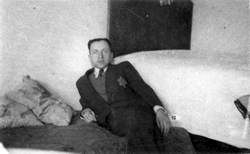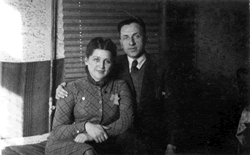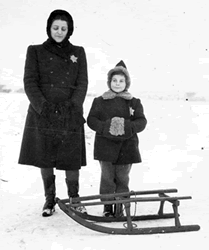Avraham Tory nee Golub
In This Photo:
Pnina Sheinzon Tory f , Avraham Tory nee Golub. Pnina is the daughter Arie Shmuel Leib Uspiz Aushpiz Aushpitz? andTzila Uspiz Aushpiz Aushpitz
Wife of Avraham Tory and Pinkhas Sheinzon ( first husband perished in the holocaust)
Mother of Alina Tory Zila Tzila? Magdassi and Shulamit
Sister of Shoshana Grab; Shlomo Uspiz Aushpiz Aushpitz; Avraham Uspiz Aushpiz Aushpitz?; Binyamin Uspiz Aushpiz Aushpitz?? and Moshe Uspiz Aushpiz Aushpit?
Kaunas, Lithuania, Pnina Shinzon Tory with her daughter Shlomit in the ghetto
Avraham Tory nee Golub, 92, Whose Diary Told the World of Nazi Crimes
By KATHLEEN CARROLL
Published: March 18, 2002

Avraham Tory ( son of Sara Leah and Zerach Golub) , a Lithuanian Jew whose meticulous diary chronicled three years of murderous Nazi rule and was later included as evidence in war crimes trials, died on Feb. 24 at his home in Tel Aviv. He was 92.
In the Jewish ghetto in Kovno, in central Lithuania, Mr. Tory, a lawyer, served as secretary of the Jewish Council of Elders, an administrative agency formed by the Nazis to carry out their orders. As secretary, he was allowed to leave the ghetto, and had access to a sea of paperwork that documented the horrors he was recording. In almost daily entries in Yiddish from June 1941 to January 1944, Mr. Tory detailed his meetings with Nazi officers and Jewish leaders.
Mr. Tory was helped by Pnina Sheinzon, who took dictation and hid the diary in her home. Few people knew about the diary, and the notebooks were buried underground in large crates as soon as Mr. Tory filled them.
In each, he included a note. ''I am hiding in this crate what I have written, noted and collected,'' he wrote, ''with thrill and anxiety, so that it may serve as material evidence -- 'corpus delicti' -- accusing testimony when the Day of Judgment comes.''
In 1944, he and Miss Sheinzon escaped the ghetto. They soon married, and moved to Israel in 1947.
After the war, Mr. Tory recovered three of the five hidden crates. In the 1980's, he was a witness in the trials of Kovno's former mayor and several Nazi war criminals.
In 1990, an English translation of the diary was published. In 1997, ''Surviving the Holocaust: The Kovno Ghetto Diary'' formed the basis for a two-year exhibit at the United States Holocaust Memorial Museum in Washington. The diary's importance is in its ''relentless details,'' said Sara Bloomfield, director of the museum.
At the exhibit's opening, Mr. Tory said: ''I felt an irresistible compulsion to keep a record of what was happening. Even if some people would survive, nobody would believe what happened to us.''
The diary was also the subject of a documentary film, ''Kovno Ghetto: A Buried History.'' The original documents are housed at Yad Vashem in Jerusalem, a museum dedicated to the Holocaust. A Lithuanian translation was published in 2000.
Avraham Tory was born Avraham Golub in Lazdijai, Lithuania, in 1909. He competed as a gymnast in the first Maccabiah Games in Tel Aviv in 1932, and studied law at the University of Pittsburgh and at the University of Kovno.
In addition to his wife, Mr. Tory is survived by three daughters, also in Israel, Shulamit Karbi, Alina Tory, and Tzila Magdassi, and by 6 grandchildren and 12 great-grandchildren.
http://collections.ushmm.org/search/catalog/irn504724Oral History
Interview Summary:
Pnina Tory (née Oshpitz), born in 1913 in Lazdijai, Lithuania, describes her family; moving to and living in Kaunas when the war began, at which point her entire family was taken to jail for three days; the death of her first husband, Pinchas Sheinzon, at the Seventh Fort; entering the Kaunas ghetto with her daughter, Shulamit; assisting Avraham Tory, who was keeping a diary of life in the ghetto, by hiding the pages of the diary and taking dictation from him when he was too tired to write; Escaping from the Gehtto in March 1944. marrying Avraham on August 10, 1944 after kaunas was liberated; leaving the Soviet Union with her daughter and husband in March 1945 and settling in Budapest, Hungary; sneaking into Italy, where she stayed for two years, with the help of a Palestinian Jewish Brigade; and immigrating to Palestine with Avraham and Shulamit on October 17, 1947.

